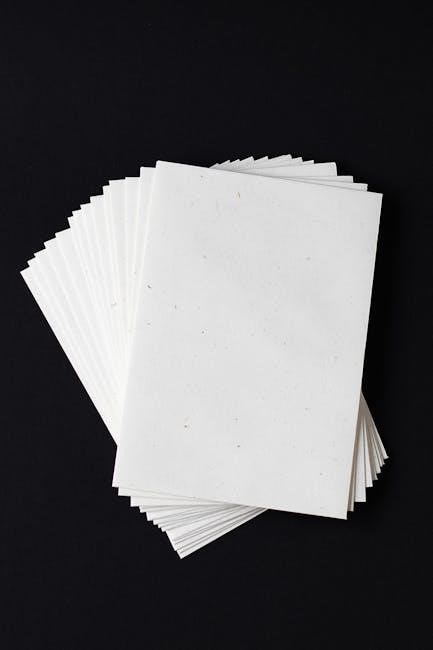Zoom Whitening Post-Op Instructions: A Comprehensive Guide
Congratulations on achieving a brighter smile through Zoom Whitening! This guide offers essential post-operative instructions to ensure optimal results, manage potential sensitivity, and maintain your dazzling, healthy smile for the long term․
Following your Zoom Whitening treatment, proper aftercare is crucial for maximizing and prolonging your results․ The initial 48 hours are particularly important, as your teeth are more susceptible to staining and sensitivity․ This guide provides comprehensive instructions on managing potential side effects, such as tooth sensitivity and color spotting due to temporary dehydration․ By adhering to these guidelines, including dietary recommendations and oral hygiene practices, you can maintain your brighter, healthier smile for up to two years․ Remember that your dentist’s specific instructions should always be prioritized, as they are tailored to your individual needs and treatment plan․
The Importance of the First 48 Hours
The first 48 hours after your Zoom Whitening procedure are critical for solidifying and enhancing your whitening results․ During this period, your teeth are more porous and susceptible to staining agents․ It’s essential to adhere strictly to the “white diet,” avoiding any foods or beverages that could compromise your newly whitened smile․ Additionally, heightened tooth sensitivity is common during this time․ Following the recommended aftercare instructions diligently will help minimize discomfort and ensure the longevity of your brighter smile․ Remember, the whitening process continues during these initial 48 hours, making your adherence to these guidelines particularly important for achieving optimal and long-lasting results․
Understanding Potential Tooth Sensitivity
Tooth sensitivity is a common side effect following Zoom Whitening, typically manifesting within the first 12 to 24 hours․ This sensitivity can range from mild discomfort to sharp, shooting pains, often referred to as “zingers․” The whitening process temporarily dehydrates the teeth, exposing the dentin and making them more susceptible to temperature changes and certain foods․ While sensitivity is usually temporary, understanding its causes and having strategies to manage it is crucial for a comfortable recovery․ Factors like pre-existing sensitivity or thin enamel can influence the degree of discomfort experienced․ Rest assured, effective methods exist to alleviate this sensitivity and ensure a positive whitening experience․

Managing Tooth Sensitivity After Zoom Whitening
Post-whitening tooth sensitivity can be effectively managed․ Several methods, including desensitizing toothpaste and relief gels, can provide relief․ Addressing sensitivity promptly ensures a comfortable recovery and a brighter smile․
Using Desensitizing Toothpaste
Desensitizing toothpaste is a simple yet effective way to combat tooth sensitivity after Zoom Whitening․ These toothpastes contain ingredients like potassium nitrate or stannous fluoride, which help block pain signals from the tooth’s surface to the nerve․ Regular use of desensitizing toothpaste, starting immediately after the whitening procedure, can significantly reduce discomfort․
Apply a pea-sized amount to a soft-bristled toothbrush and brush gently, paying extra attention to sensitive areas․ It’s also beneficial to leave the toothpaste on your teeth for a minute or two after brushing, allowing the active ingredients to work more effectively․ Continue using the desensitizing toothpaste for as long as sensitivity persists․
Applying Relief ACP Gel with Take-Home Trays
Relief ACP (Amorphous Calcium Phosphate) gel is a valuable tool for managing tooth sensitivity following Zoom Whitening․ Your dentist may provide you with take-home trays designed to fit your teeth precisely․ To use Relief ACP gel, dispense a small amount into each tooth compartment of the tray, focusing on areas where you experience the most sensitivity․
Carefully insert the trays into your mouth, ensuring they are seated correctly against your teeth․ Wear the trays for the duration recommended by your dentist, typically 30-60 minutes․ The ACP gel helps remineralize tooth enamel, reducing sensitivity and promoting overall tooth health․ Rinse your mouth gently with water after removing the trays․
Other Methods for Sensitivity Relief
Besides desensitizing toothpaste and Relief ACP gel, several other methods can help alleviate tooth sensitivity after Zoom Whitening․ Over-the-counter pain relievers, such as ibuprofen or acetaminophen, can provide temporary relief from discomfort․ Applying a cold compress to the outside of your cheek near the sensitive area can also help numb the pain․
Some individuals find that avoiding very hot or cold foods and beverages reduces sensitivity․ Rinsing your mouth with warm salt water can soothe irritated gums and reduce inflammation․ If sensitivity persists or becomes severe, contact your dentist for further evaluation and personalized recommendations․ They may prescribe a stronger desensitizing agent or recommend other treatment options․

Dietary Recommendations Post-Whitening
Following Zoom Whitening, dietary choices are crucial․ Embrace the “white diet,” consuming light-colored foods․ Avoid staining agents like coffee and red wine to preserve your newly brightened smile․
The “White Diet”: Foods to Consume
After your Zoom Whitening treatment, adhering to a “white diet” is crucial for maintaining your brilliant results․ This diet focuses on foods that are light in color and less likely to cause staining․ Opt for items like white rice, plain yogurt, and cauliflower․ Clear soups and white fish are also good choices․
Bananas are a great option, as are peeled potatoes․ Consider drinking milk, which is not only safe but also beneficial for your teeth․ Remember, the goal is to avoid dark-colored foods that can compromise your newly whitened smile during this sensitive period․ Staying consistent with these food choices in the initial days following your procedure is an investment in the longevity of your brighter, healthier smile․ These foods will keep you feeling great and looking even better!

Foods and Drinks to Avoid After Whitening
To protect your newly whitened smile after Zoom Whitening, it’s essential to avoid certain foods and drinks that can cause staining․ Steer clear of dark-colored beverages like coffee, tea, red wine, and cola․ Avoid deeply pigmented foods such as berries, chocolate, soy sauce, and tomato-based products․
Also, it is important to cut back on citrus fruits and juices that can increase sensitivity․ Be cautious with spices like turmeric and paprika, which can stain․ Essentially, if it can stain a white shirt, avoid it! By carefully avoiding these items, you’ll significantly extend the life of your whiter, brighter smile and enjoy the full benefits of your whitening treatment․ Remember, avoiding them is a short term sacrifice for long term gain․
Easing Dietary Restrictions After the Initial Period
After the initial 48-hour period following your Zoom Whitening treatment, you can gradually reintroduce some of the foods and drinks you’ve been avoiding․ However, moderation is key to maintaining your bright smile․ Consider incorporating stain-causing items back into your diet slowly, observing how your teeth react․
Continue to limit your consumption of coffee, tea, and red wine, and always rinse your mouth with water after consuming them․ If you notice any staining, consider using a whitening toothpaste to help combat discoloration․ Remember, maintaining a good oral hygiene routine, including regular brushing and flossing, will also assist in keeping your smile bright․ Listen to your dentist’s specific recommendations for the best approach․

Oral Hygiene Practices After Zoom Whitening

Maintaining proper oral hygiene is crucial post-whitening․ Gentle brushing, flossing, and rinsing are essential for removing stains and plaque․ This helps preserve your newly brightened smile and overall oral health․
Gentle Brushing and Flossing Techniques
After undergoing Zoom whitening, your teeth may be more sensitive than usual, so employing gentle brushing and flossing techniques is vital․ Use a soft-bristled toothbrush and avoid applying excessive pressure․ Focus on brushing in gentle, circular motions, ensuring you reach all surfaces of each tooth․ When flossing, be careful not to snap the floss against your gums․ Instead, slide it gently between your teeth and use a seesaw motion to remove plaque and debris․
Remember, aggressive brushing and flossing can irritate your gums and potentially cause sensitivity․ Prioritize thoroughness and gentleness to maintain optimal oral hygiene without compromising comfort․
Using a Soft-Bristled Toothbrush
Following your Zoom whitening treatment, it is crucial to switch to a soft-bristled toothbrush․ This type of brush is designed to be gentle on your teeth and gums, which may be more sensitive than usual after the procedure․ Avoid using medium or hard-bristled brushes, as they can cause irritation and discomfort․
A soft-bristled toothbrush will effectively remove plaque and debris without damaging the enamel or irritating the gums․ Remember to replace your toothbrush every three months or sooner if the bristles become frayed․ Proper brushing technique, combined with a soft-bristled brush, is essential for maintaining oral hygiene and protecting your newly whitened smile․
Rinsing with Water or Mouthwash After Meals
After each meal, especially during the initial 48 hours post-whitening, rinsing your mouth thoroughly with water or a dentist-approved mouthwash is highly recommended․ This practice helps to dislodge any food particles that may be trapped between your teeth and reduces the potential for staining․
Opt for a mouthwash that is alcohol-free to prevent dryness and irritation․ Swishing with water or mouthwash also aids in neutralizing acids in your mouth, further protecting your enamel․ Make sure to gently swish the liquid around your mouth for at least 30 seconds before spitting it out․ This simple step will contribute significantly to maintaining your brighter, whiter smile․

Maintaining Long-Term Whitening Results
To enjoy your dazzling smile for years, consistent oral hygiene, regular dental visits, and touch-up treatments are essential․ Lifestyle choices also play a significant role in preserving your whitening results․

Regular Dental Check-ups and Cleanings
Maintaining your bright, white smile after Zoom whitening requires more than just at-home care․ Regular dental check-ups and professional cleanings are crucial for long-term success․ These appointments allow your dentist to monitor your oral health, address any emerging issues, and remove surface stains that can dull your smile over time․ During a cleaning, your hygienist will remove plaque and tartar buildup, which can contribute to discoloration and compromise the overall appearance of your teeth․
Furthermore, your dentist can assess the longevity of your whitening treatment and recommend appropriate touch-up procedures to maintain your desired shade․ Regular visits also provide an opportunity to discuss any concerns you may have regarding sensitivity or staining․ By adhering to a consistent schedule of dental check-ups and cleanings, you can proactively protect your investment in a brighter, more confident smile․
Take-Home Whitening Trays for Touch-Ups
To prolong the effects of your Zoom whitening treatment, consider using take-home whitening trays for periodic touch-ups․ Your dentist can provide custom-fitted trays and whitening gel formulated for at-home use․ These trays allow you to conveniently maintain your bright smile in between professional treatments․ Generally, it is recommended to wait three days after your in-office Zoom whitening before commencing at-home touch-ups, if your teeth are not too sensitive․
Follow your dentist’s instructions carefully regarding the duration and frequency of each touch-up session․ Overuse of whitening products can lead to increased sensitivity, so moderation is key․ Take-home trays offer a convenient and effective way to combat staining from food, drinks, and lifestyle habits, ensuring your smile remains radiant for years to come․ They empower you to actively manage and maintain your whitening results․
Lifestyle Choices for Maintaining a Bright Smile
Maintaining a bright smile after Zoom whitening involves adopting certain lifestyle choices that minimize staining and promote oral health․ Limit consumption of stain-causing substances like coffee, tea, red wine, and dark-colored sodas․ When you do indulge, use a straw to minimize contact with your teeth and rinse your mouth with water afterward․ Avoid tobacco products, as they are notorious for causing severe staining․
Prioritize excellent oral hygiene by brushing and flossing regularly․ Schedule regular dental check-ups and cleanings to remove plaque and surface stains․ These habits work synergistically to protect your investment in a brighter smile․ By making informed choices about your diet and oral care routine, you can extend the longevity of your whitening results and enjoy a confident, radiant smile for years to come․ Remember, consistency is key!

Addressing Specific Concerns
Following Zoom whitening, some individuals may experience specific concerns like color spotting or increased sensitivity․ This section provides guidance on addressing these issues and knowing when to seek professional dental advice․
Color Spotting and Tooth Dehydration
After undergoing Zoom whitening, you might observe color spotting on your teeth․ This phenomenon often arises from temporary tooth dehydration․ During the whitening process, teeth can lose some moisture, leading to an uneven appearance․ This dehydration makes the enamel more porous, accentuating existing variations in tooth shade․
Typically, this color spotting is transient and resolves as your teeth rehydrate naturally over the following days․ As your teeth regain their moisture balance, the color will even out, revealing the true, whitened shade․ However, if the spotting persists or concerns you, consult your dentist for further evaluation and reassurance․ Proper hydration, achieved by drinking plenty of water, can aid in the rehydration process․
Impact on Existing Dental Work (Porcelain)
It’s crucial to understand that Zoom whitening primarily affects natural tooth enamel․ Existing dental work, such as porcelain veneers, crowns, or fillings, will not respond to the whitening treatment․ This means that while your natural teeth will lighten, the color of your porcelain restorations will remain unchanged․
Consequently, after whitening, you might notice a color mismatch between your natural teeth and any porcelain work․ If this difference is significant and aesthetically bothersome, consider discussing options with your dentist․ Possible solutions include replacing the porcelain restorations to match your newly whitened teeth, ensuring a uniform and pleasing smile appearance․ Your dentist can assess your specific situation and recommend the most suitable course of action․
When to Contact Your Dentist
While mild tooth sensitivity is a common side effect following Zoom whitening, it’s important to monitor your symptoms and know when to seek professional dental advice․ If you experience severe or persistent pain that doesn’t subside with over-the-counter pain relievers or desensitizing toothpaste, contact your dentist promptly․
Also, be alert for signs of gum irritation or inflammation that worsen over time․ If you notice any unusual changes in your gums or teeth, such as extreme sensitivity, white spots that persist beyond a few days, or any other concerning symptoms, don’t hesitate to reach out to your dentist․ They can assess the situation, provide appropriate treatment, and ensure your oral health remains optimal after the whitening procedure․

Additional Tips for Success
Maximize your whitening success by using a straw for dark drinks and rinsing after consuming stain-causing foods․ Follow your dentist’s specific instructions for optimal and long-lasting results․
Using a Straw for Dark-Colored Drinks
To further safeguard your newly whitened smile, consider incorporating a simple yet effective technique into your daily routine: using a straw when consuming dark-colored beverages․ This practice minimizes direct contact between the liquid and your teeth, reducing the potential for staining agents to adhere to the enamel․ Beverages such as coffee, tea, red wine, and dark sodas are notorious for causing discoloration, and a straw can act as a barrier, channeling the liquid towards the back of your mouth and bypassing the front teeth․
This strategy is especially beneficial during the initial period following your Zoom Whitening treatment, when your teeth are more susceptible to staining․ While it may seem like a minor adjustment, consistently using a straw can significantly contribute to preserving the brightness of your smile and prolonging the effects of the whitening procedure․ Remember to position the straw carefully to ensure that the liquid avoids contact with your teeth as much as possible․
Rinsing After Consuming Stain-Causing Foods/Drinks
Another crucial step in maintaining your bright smile after Zoom Whitening is to rinse your mouth thoroughly with water immediately after consuming stain-causing foods or drinks․ This simple action helps to dislodge any lingering particles and neutralize acidic substances that can contribute to discoloration․ Prompt rinsing prevents these substances from settling on the enamel and causing stubborn stains․
Water is an excellent choice for rinsing, but you can also use a fluoride mouthwash for added protection and enamel strengthening․ Be sure to choose a mouthwash that is clear and alcohol-free to avoid any potential staining or sensitivity issues․ Making rinsing a habit after every meal or snack, especially those containing staining agents, will significantly contribute to preserving the longevity of your whitening results․ This proactive approach complements other aftercare measures, such as using a straw and maintaining a proper oral hygiene routine, to ensure a lasting, radiant smile․
Following Dentist’s Specific Instructions
While this guide offers general advice, it is paramount to adhere to the specific post-whitening instructions provided by your dentist․ Each individual’s dental condition and treatment response may vary, requiring a tailored approach to aftercare․ Your dentist possesses the expertise to assess your unique needs and provide personalized guidance for optimal results and minimal discomfort․
These specific instructions might include the duration and frequency of using desensitizing products, dietary recommendations based on your teeth’s sensitivity level, and the timing of touch-up treatments․ Ignoring these personalized recommendations could compromise the effectiveness of the whitening procedure or lead to unnecessary sensitivity or complications․ Therefore, prioritize your dentist’s advice and promptly address any concerns or questions you may have․ This collaborative approach ensures the best possible outcome and long-term satisfaction with your brighter, whiter smile․
By diligently following these post-operative instructions, you are well-equipped to maintain your newly brightened smile and enjoy the confidence it brings․ Remember that the initial 48 hours are crucial for maximizing the whitening effect and minimizing sensitivity․ Consistent oral hygiene practices, a mindful diet, and regular dental check-ups are essential for long-term success․
Should you experience any unexpected issues or have concerns, do not hesitate to contact your dentist for guidance․ With proper care and attention, your Zoom Whitening results can last for an extended period, allowing you to showcase your radiant smile with pride․ Embrace your enhanced appearance and enjoy the positive impact it has on your self-esteem and overall well-being․ Your commitment to post-treatment care will ensure that your brighter smile remains a source of joy for years to come․
